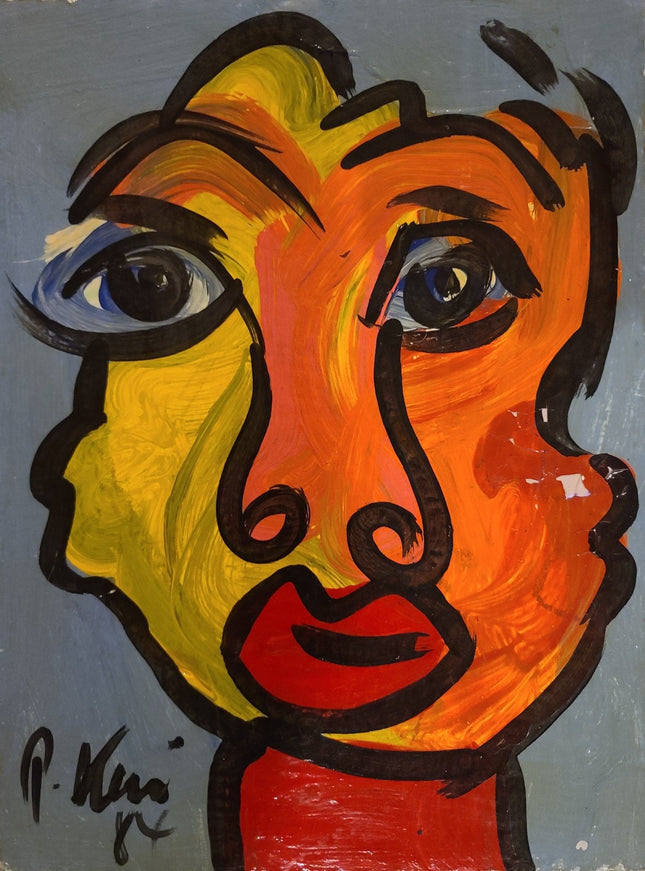
Oil Paint

Peter Keil Childs Face 84 Original Oil Painting by Peter Keil
Childs Face 84 Original One of a Kind Oil Mixed Media Painting Artwork on Cardboard by Popular Modern Impressionist Artist Peter Keil. 1984 Signed 12x16 Original Peter Keil Painting of a large child boy's face. Some paint chipped on the cheek, as is common with Peter Keil originals. Peter Keil's Child's Face '84: A Fusion of Expressionism and Street Pop Art The "Child's Face '84" by Peter Keil stands as a vibrant example of how modern impressionist techniques can intersect with the ethos of Street Pop Art and Graffiti Artwork. Measuring 12x16 inches, this original oil mixed media painting on cardboard brings forth the distinct style of Keil, often recognized for his spontaneous, bold approach to modern art. The painting, which presents a giant boy's face, encapsulates the innocence and expressiveness associated with children, rendered through the lens of Keil's vivid, impressionistic style. Characteristic of Peter Keil's original works, this piece exhibits some paint chipping on the cheek, a natural consequence of the artist's heavy impasto technique and the delicate nature of cardboard as a medium. The chips do not detract from the artwork's impact; instead, they add to the piece's narrative, reflecting the passage of time and the tactile history of Keil's artistic process. This textural element, common in Keil's originals, underscores the raw, unfiltered emotion he seeks to capture in his subjects. Interpreting Keil's Artistic Language in Child's Face '84 Interpreting Keil's "Child's Face '84" requires an appreciation of his artistic language, which merges the abstracted forms of impressionism with street art's vibrant colors and emotional immediacy. Keil's portrayal goes beyond simply representing a child's features; it explores character and emotion conveyed through exaggerated forms and a rich color palette. The large, luminous eyes dominate the composition, serving as windows to the child's soul and echoing the depth of human experience that Keil aims to explore through his art. The choice of cardboard as a substrate for this piece mainly tells of Keil's intention to bridge the gap between conventional fine art and the more accessible, everyday materials often used in Street Pop Art and Graffiti Artwork. This unconventional choice reflects a democratization of art, a key theme in street art, where the emphasis is on making art available and relatable to a broad audience. By utilizing cardboard, Keil challenges traditional art norms and aligns himself with a form of artistic expression grounded in the realities of urban life. The Lasting Influence of Keil's Approach to Portraiture The lasting influence of Peter Keil's approach to portraiture is evident in "Child's Face '84." His work, often categorized under the umbrella of modern impressionism, resonates with a broader range of art forms, including Street Pop Art and Graffiti Artwork. Keil's contribution to these genres lies in his ability to infuse traditional portrait painting with a sense of immediacy and street-wise rawness often found in urban art. This painting, with its bold contours and striking colors, is a testament to Keil's innovative spirit and impact on contemporary art. Furthermore, the painting's vibrant quality, a defining characteristic of Keil's work, underscores the expressive potential of Street Pop Art and Graffiti Artwork. "Child's Face '84" exemplifies how these genres can convey complex emotional narratives, challenging the perception that street art is solely concerned with public commentary or social critique. Keil's portrait is a celebration of individuality and the human spirit, encapsulated within the gaze of a child and articulated through the medium of paint. Peter Keil's "Child's Face '84" is a significant piece that captures the intersection of modern impressionism with the dynamic world of Street Pop Art and Graffiti Artwork. The painting's spontaneous execution, vibrant colors, and textural nuances contribute to its enduring appeal and status as a meaningful representation of Keil's artistic vision. As a piece that bears the marks of its creation, it continues to engage and inspire, offering a window into the depth and diversity of Keil's oeuvre.
$294.00


